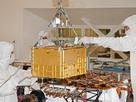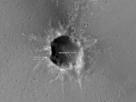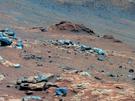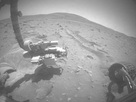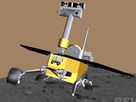Alpha Particle X-ray
Advanced NASA Instrument Gets Close-up on Mars Rocks
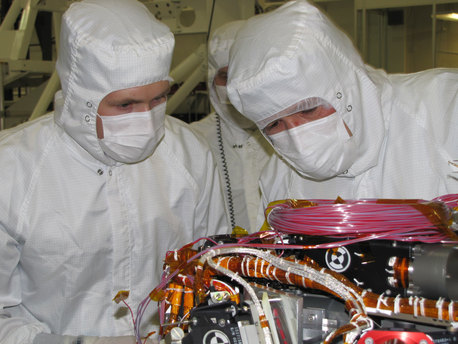 © NASA/JPL-Caltech
|
Image shows Grad student Nicholas Boyd (left) and Principal Investigator Ralf Gellert, both of the University of Guelph, Ontario, Canada, preparing for the installation of the sensor head on the Alpha Particle X-ray Spectrometer instrument during testing at NASA's Jet Propulsion Laboratory.The instrument is part of the Curiosity rover, which will fly on NASA's Mars Science Laboratory mission. The sensor head is 7.8 centimeters, or about 3 inches tall.
Identifying the elemental composition of lighter elements such as sodium, magnesium or aluminum, as well as heavier elements like iron, nickel or zinc, will help scientists identify the building blocks of the Martian crust. By comparing these findings with those of previous Mars rover findings, scientists can determine if any weathering has taken place since the rock formed ages ago.
All NASA Mars rovers have carried a similar instrument – Pathfinder's rover Sojourner, Spirit and Opportunity, and now Curiosity, too. Improvements have been made with each generation, but the basic design of the instrument has remained the same.
"APXS was modified for Mars Science Laboratory to be faster so it could make quicker measurements. On the Mars Exploration Rovers [Spirit and Opportunity] it took us five to 10 hours to get information that we will now collect in two to three hours," said Gellert, the instrument's principal investigator. "We hope this will help us to investigate more samples."
Another significant change to the next-generation APXS is the cooling system on the X-ray detector chip. The instruments used on Spirit and Opportunity were able to take measurements only at night. But the new cooling system will allow the instrument on Curiosity to take measurements during the day, too.
The main electronics portion of the tissue-box-sized instrument lives in the rover's body, while the sensor head, the size of a soft drink can, is mounted on the robotic arm. With the help of Curiosity's remote sensing instruments – the Chemistry and Camera (ChemCam) instrument and the Mastcam – the rover team will decide where to drive Curiosity for a closer look with the instruments, including APXS. Measurements are taken with the APXS by deploying the sensor head to make direct contact with the desired sample.
The rover's brush will be used to remove dust from rocks to prepare them for inspection by APXS and by MAHLI, the rover's arm-mounted, close-up camera. Whenever promising samples are found, the rover will then use its drill to extract a few grains and feed them into the rover's analytical instruments, SAM and CheMin, which will then make very detailed mineralogical and other investigations.
Scientists will use information from APXS and the other instruments to find the interesting spots and to figure out the present and past environmental conditions that are preserved in the rocks and soils.
"The rovers have answered a lot of questions, but they've also opened up new questions," said Gellert. "Curiosity was designed to pick up where Spirit and Opportunity left off."
Source: NASA
Alpha Particle X-ray
Advanced NASA Instrument Gets Close-up on Mars Rocks
 © NASA/JPL-Caltech
|
Image shows Grad student Nicholas Boyd (left) and Principal Investigator Ralf Gellert, both of the University of Guelph, Ontario, Canada, preparing for the installation of the sensor head on the Alpha Particle X-ray Spectrometer instrument during testing at NASA's Jet Propulsion Laboratory.The instrument is part of the Curiosity rover, which will fly on NASA's Mars Science Laboratory mission. The sensor head is 7.8 centimeters, or about 3 inches tall.
Identifying the elemental composition of lighter elements such as sodium, magnesium or aluminum, as well as heavier elements like iron, nickel or zinc, will help scientists identify the building blocks of the Martian crust. By comparing these findings with those of previous Mars rover findings, scientists can determine if any weathering has taken place since the rock formed ages ago.
All NASA Mars rovers have carried a similar instrument – Pathfinder's rover Sojourner, Spirit and Opportunity, and now Curiosity, too. Improvements have been made with each generation, but the basic design of the instrument has remained the same.
"APXS was modified for Mars Science Laboratory to be faster so it could make quicker measurements. On the Mars Exploration Rovers [Spirit and Opportunity] it took us five to 10 hours to get information that we will now collect in two to three hours," said Gellert, the instrument's principal investigator. "We hope this will help us to investigate more samples."
Another significant change to the next-generation APXS is the cooling system on the X-ray detector chip. The instruments used on Spirit and Opportunity were able to take measurements only at night. But the new cooling system will allow the instrument on Curiosity to take measurements during the day, too.
The main electronics portion of the tissue-box-sized instrument lives in the rover's body, while the sensor head, the size of a soft drink can, is mounted on the robotic arm. With the help of Curiosity's remote sensing instruments – the Chemistry and Camera (ChemCam) instrument and the Mastcam – the rover team will decide where to drive Curiosity for a closer look with the instruments, including APXS. Measurements are taken with the APXS by deploying the sensor head to make direct contact with the desired sample.
The rover's brush will be used to remove dust from rocks to prepare them for inspection by APXS and by MAHLI, the rover's arm-mounted, close-up camera. Whenever promising samples are found, the rover will then use its drill to extract a few grains and feed them into the rover's analytical instruments, SAM and CheMin, which will then make very detailed mineralogical and other investigations.
Scientists will use information from APXS and the other instruments to find the interesting spots and to figure out the present and past environmental conditions that are preserved in the rocks and soils.
"The rovers have answered a lot of questions, but they've also opened up new questions," said Gellert. "Curiosity was designed to pick up where Spirit and Opportunity left off."
Source: NASA






